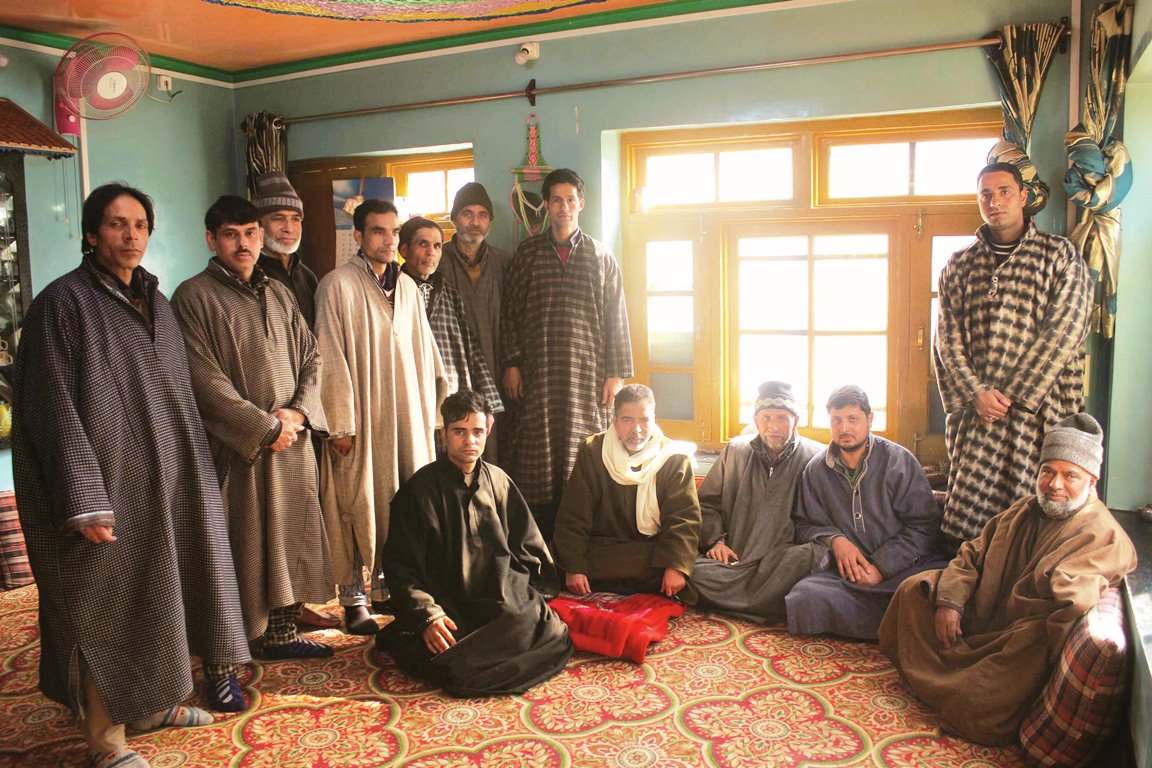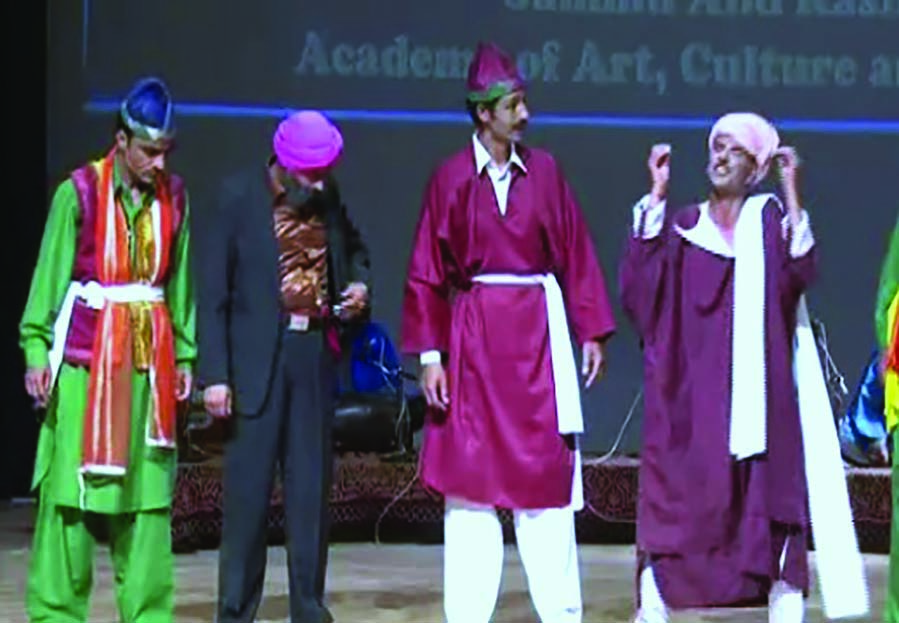Farzana Nissar treks deep-south to report the lonely fight of a peripheral theatre cluster to preserve Bhand Pather

Members of Bhagat theatre. KL Image by Farzana Nissar
The road to Mohripora, barely 4 kms from Achabal, snakes through snowy mountains with trees lining its both sides. Seemingly, it is named after the Mohri caste of Kashmiri Pandits, who fled the village in the early nineties after the outbreak of militancy. In the Bhagat Mohalla of the village, is the house of Ghulam Mohammad Bhagat, distinctively known as Gul Mohirpoore among the residents.
In a big hall of his well-built house, men, young and old, dressed in bright ethnic clothes are rehearsing for their upcoming play, Luke-Lore. Popularly known as Bhands, these men are part of Alamdar Bhagat Theatre, one of Kashmir’s oldest folk troupes. Under the stewardship of Ghulam Mohammad, the theatre is in the vanguard of the struggle to safeguard the Valley’s dying folk tradition.
“We would have left this profession years back, hadn’t there been Gul Sahab to keep us all motivated and connected to our roots,” says Ghulam Nabi Bhagat, a member of the theatre.
Back in 1960, Mohammad Subhan Bhagat, a well-known folk theatre personality, organized the then theatre artists of Mohripora and its adjacent village Akingam and named the group as Kashmir Bhagat Theatre. After Radio Kashmir Srinagar recognized the talent in these village boys, the group became the first registered theatre of Kashmir. Mohammad Subhan also gave a formal script to Bhand Pathers (folk plays) in his book titled Bhand-Jashen. Since then the art kept passing down through families.
Ghulam Mohammad, 55, also comes from one such family of artists. He has been performing for more than 40 years now. His father Late Ghulam Rasool Bhagat with a stage name Rasul Bache, was groomed as a performer by his father-in-law Fateh Bhagat.
Later in 1975 when drama clubs were formed in every nook and corner of the valley, Ghulam Mohammad too adopted this art. He knows the art of direction, writing scripts and is an actor as well. Now his son, Muzaffar Ahmad Bhagat, 28, plays Rabab for the group and also acts sometimes. Villagers credit the family for working zealously towards preserving Bhand Pather. Recalling his first Pather, Ghulam Mohammad says that the play is still remembered as one of the most dramatic plays of their lives. Named choklad jigar (bruised heart), Ghulam Mohammad played a government employee, his friend Santosh Kashmiri, a Kashmiri Pandit played an unemployed boy. Other roles were that of a teacher, a tractor driver, and a police-man.
“It was destined for us, as if Allah was writing our fate at the same time when we were performing,” says Ghulam Mohammad, who works in the Fisheries department apart from being a theatre artist.
A short distance from Ghulam Mohammad’s house is the house of Mohammad Iqbal Bhagat, 75. Standing near the window of his modest room with a walking stick in his hand, he is keenly watching the water droplets fall from the cone-shaped icicles hanging from the slanting edge of his roof. He is the eldest in the troupe and has performed in hundreds of Bhand Pathers. Two years ago Mohammad Iqbal suffered from a brain hemorrhage, after which he has developed problems with his mobility. Being the lone bread-earner in the family of five, someone had to take over the responsibilities. So his son Akash Iqbal, a 15-year-old school boy, decided to join the group.
“My father is the eldest of all and now I am the youngest,” says Akash with a giggle. “I love doing what I do. Although I know this is a dying art with no future but this is what I have seen my father doing since I was a kid.”
Bhagats of Mohripora aren’t the only people associated with this age-old traditional folk-theatre. People from other backgrounds also desire to play their part in keeping Bhand Pather alive. One such example is that of Gulzar Ahmad Mughloo. A BUMS doctor by profession and a resident of the adjacent Akingam, Mughloo is one of the scriptwriters for the Alamdar Bhagat Theatre.
“When I was a tenth class student, I acted in a Bhand pather for our Nadeem dramatic club. I carry the experience with me since then,” says Mughloo.
In the nineties, Bhand performances in Kashmir were affected by militancy. The performances resumed a decade later. In 2005, Mughloo got his theatre group registered as an NGO. The non-profit organization works on key issues of Art and culture, child and youth development, education and literacy, employment, human rights, and disaster management, with an aim to promote and preserve the Bhand Pather. The NGO gets funds from projects sponsored by Ministry of Culture, Government of India and Jammu and Kashmir Academy of Art, Culture, and Languages. Sangeet Natak Academi, the national academy of music, dance, and drama, also provides it financial assistance through assignments.
“One of the major reasons I got the theatre registered as an NGO is that the funds that we get through it help the group members to earn a livelihood. Otherwise, it would have been difficult for them to be a part of a group which could give them nothing,” he says. “Due to the decline of this form of art in Kashmir, artists have shifted to other professions, so there is a strong need to take into consideration the financial needs of the artists to help Bhand Pather survive”.
Not only Mughloo but his son Adil Gulzar, who is pursuing his PhD in Political Science, acts as an anchor for Alamdar Bhagat Theatre. A lover of Kashmiri traditions, Adil wants to preserve this dying art as he believes that Bhand Pather is not only a part of our culture but also one of the facets of our identity.
“Since most of the members of the theatre are illiterates, I act as a translator and host the folk plays in the English language, whenever we perform outside the state or for foreign audiences,” says Adil. “Young generation of Kashmir often looks at Bhands as alien to them. It’s important to make them aware that it is not a title given to some particular section of the society but the richest traditional theatre-art form of Kashmir.”
Over the years people from other areas have joined the group. Maqsood Hussain Bhagat hails from Wathoora village of Budgam and is the coordinator of Alamdar Bhagat Theatre. Maqsood says that his forefathers were Bhands. His father Ghulam Mohideen Aijiz, a famous folk theatre artist has given a formal script to some folk plays in a book titled Soan Meeras. When Maqsood completed his graduation, he decided to go for a post-graduation in Kashmiri, so that he could somehow contribute to his familial occupation.
“It is very important for a script to have a clean and decent vocabulary,” says Maqsood, who is a script editor for the group. “Now when I have a good knowledge of my mother tongue I can easily edit the scripts.”
Zulfikar Ahmad Bhat, another person from Wathoora who joined the group in 2011, works as its cameraman. His job is to shoot the plays and send the copies to different concerned departments.
“I have shot a number of plays,” Zulfikar says. “I get paid for this.”
Asiv nay te Lasiv Kati
Highlighting the importance of Bhand Pathers, Ghulam Mohammad says the art form portrays social, cultural, religious and political dilemmas prevailing in the state.
“With a mixture of play, music and dance shot through with wit and humour, the messages are conveyed to the audience while making them laugh,” he says. “In earlier times, the Bhands used to perform from village to village while wandering and collecting food, money, and clothes which was their only source of income and survival”.
Bhands, he continues, also were invited to marriage ceremonies of royals, and landlords.
“They would perform for days together and enjoyed a popular social recognition,” says Ghulam Mohammad. “Almost all the Pathers were played extempore”.
Most popular Pathers of the time were “Grees-Pather” (a play about farmers), Watal-Pathers (play about cobblers), Darzi-Pather (a play portraying the tyranny of the Dards), Bakerwal-Pather (a play about a nomad tribe of Kashmir), Buhri-Pather (play about the traders), Raze-Pather (play about the Rajas), Shikar-Gah Pather (play about the animal kingdom and the human behavior towards animals), Gosani-Pather (play about Hindu-hermits), Angreez-Pather (play about the Englishmen), Armeen-Pather (play about the vegetable-growers) , Hanz-Pather (play about fishermen), Chakwal-Pather (play about Chakdars) and many more. There was hardly any social group, which was not covered by Bhands in their Pathers.
Artists of Bhagat theatre have staged their plays not only in Kashmir but in every metropolis of the country. They have won many state and national awards. Every year they are being called to Republic Day functions to showcase their talent. Many of its members have mastery in playing musical instruments like Rabab, Sarangi, Nout, Harmonium, and Dholki.
Some of the acclaimed productions of the group include Watish Armaan, Watish Weach, Gulalan Daad Lalwun, Crack-down, Byabooj, Wakhtuk Aalew, Nov Aalew, Gate te Gaash and many more. In a festival at Tagore Hall Srinagar which was organized by Sangeet Natak Akademi and Jammu and Kashmir Academy of Art, Culture and Languages in 2006, Alamdar Bhagat Theatre got the first position.
“Nearly 26 theatres from different parts of Kashmir participated in the festival, and when our name was announced as winners, it was a moment of great pride for us. We were ecstatic with joy,” says Farooq Ahmad, a member.

Members of Bhagat Theatre performing in an event organised by J&K Academy of Art, Culture and Languages.
Apart from government-sponsored events, the group actively performs at shrines of Sufi saints across the valley. “Whenever we perform on a Urs we don’t ask people for money but whatever they give, they give it out of their own will.”
In winter of 2013, members of this group were visited by famous Bollywood director Vishal Bhardwaj, who offered them work in his movie Haider.
“We immediately accepted the offer. Who could have afforded to miss such a great chance?” says Ghulam Nabi Bhagat, a group member. “We shot with him for eight days at the famous Martand temple of Mattan in Islamabad. It was a great experience.” The group has appeared in the movie’s famous song Bismil.
Concerns
There was a time when almost every second household from the twin villages of Mohripora and Akingam were associated with this art but today only a few are left. This worries the elderly in the Bhagat group.
“Once a theatre of 250, our group is reduced to just 28 members,” says Mohammad Iqbal, with a sigh. He requests all stakeholders in Kashmir to help to preserve the art. “As people, we are bound to suffer from an identity crisis as we are leaving our roots”.
However, Iqbal believes that the Bhand Pather has to adapt to the times to survive. “We completely understand that the tastes of people have changed and it is important to contemporize the plays. But unfortunately, we are not allowed to do so,” he says. “We are artists, we can do anything”.
from Kashmir Life https://ift.tt/3bpa0Mq
via IFTTThttps://kashmirlife.net
No comments:
Post a Comment